
- Home
- India
- World
- Premium
- THE FEDERAL SPECIAL
- Analysis
- States
- Perspective
- Videos
- Sports
- Education
- Entertainment
- Elections
- Features
- Health
- Business
- Series
- In memoriam: Sheikh Mujibur Rahman
- Bishnoi's Men
- NEET TANGLE
- Economy Series
- Earth Day
- Kashmir’s Frozen Turbulence
- India@75
- The legend of Ramjanmabhoomi
- Liberalisation@30
- How to tame a dragon
- Celebrating biodiversity
- Farm Matters
- 50 days of solitude
- Bringing Migrants Home
- Budget 2020
- Jharkhand Votes
- The Federal Investigates
- The Federal Impact
- Vanishing Sand
- Gandhi @ 150
- Andhra Today
- Field report
- Operation Gulmarg
- Pandemic @1 Mn in India
- The Federal Year-End
- The Zero Year
- Science
- Brand studio
- Newsletter
- Elections 2024
- Events
A 'bonsai' love story of growing small trees watered with creativity

Every year, Bengaluru-based botanist and bonsai master Anupama Vedachala goes to Venezuela's capital Caracas and spends a month to hone her skills under the tutelage of her teacher and bonsai expert Nacho Marin. Vedachala, 50, herself has trained hundreds of bonsai enthusiasts to grow trees in pots but says there is no end to learning and perfecting growing miniature trees.“Growing...
Every year, Bengaluru-based botanist and bonsai master Anupama Vedachala goes to Venezuela's capital Caracas and spends a month to hone her skills under the tutelage of her teacher and bonsai expert Nacho Marin. Vedachala, 50, herself has trained hundreds of bonsai enthusiasts to grow trees in pots but says there is no end to learning and perfecting growing miniature trees.
“Growing and nurturing bonsais requires a great set of skills. The most important of them is patience. It is no easy task to grow forests in pots and trays,” adds Vedachala, on the sidelines of a recently held two-day-long bonsai exhibition in Bengaluru.
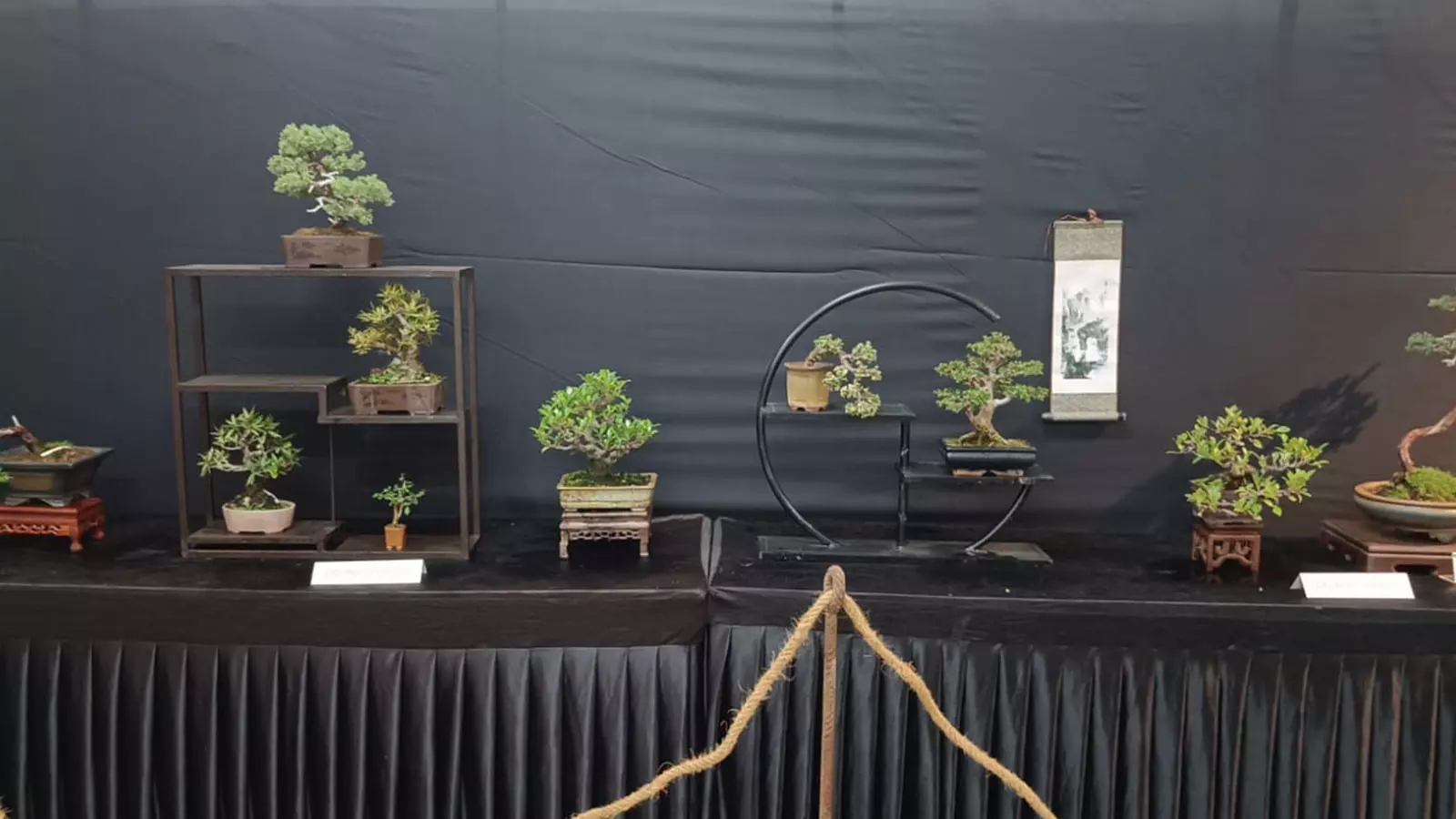
Small is beautiful: Bonsais are best suited for an urban milieu as they require less water and space. Photos: Maitreyee Boruah
The exhibition was hosted by — Vriksha Bonsai Circle — a group founded by bonsai growers in Karnataka's capital in 1990.
Today, Vriksha (tree) has around 80 members.
As one entered the exhibition featuring around 300 miniature trees, it was like stepping inside a forest in an urban space. The visitors were awestruck as they were greeted by banyan, peepal, bougainvillea, gulmohar, lavender, mango, tamarind and Chinese lemon, to name a few, held in small pots chiselled to perfection. Vriksha has been hosting a bonsai exhibition every two years. However, because of the coronavirus pandemic, the group hosted this year's exhibition after a gap of five years.
Some of the trees at the exhibition were as old as 60 years. Champa Kabra, a bonsai grower and joint secretary of Vriksha, passionately spoke about her 60-year-old bougainvillea plant. She had inherited it from her late aunt Gangu Mandappa. "I have a collection of 500 bonsais. They are all atop my terrace. I have brought 30 of them to the exhibition. The bonsais are like my children. I take care of them daily," says the 64-year-old.
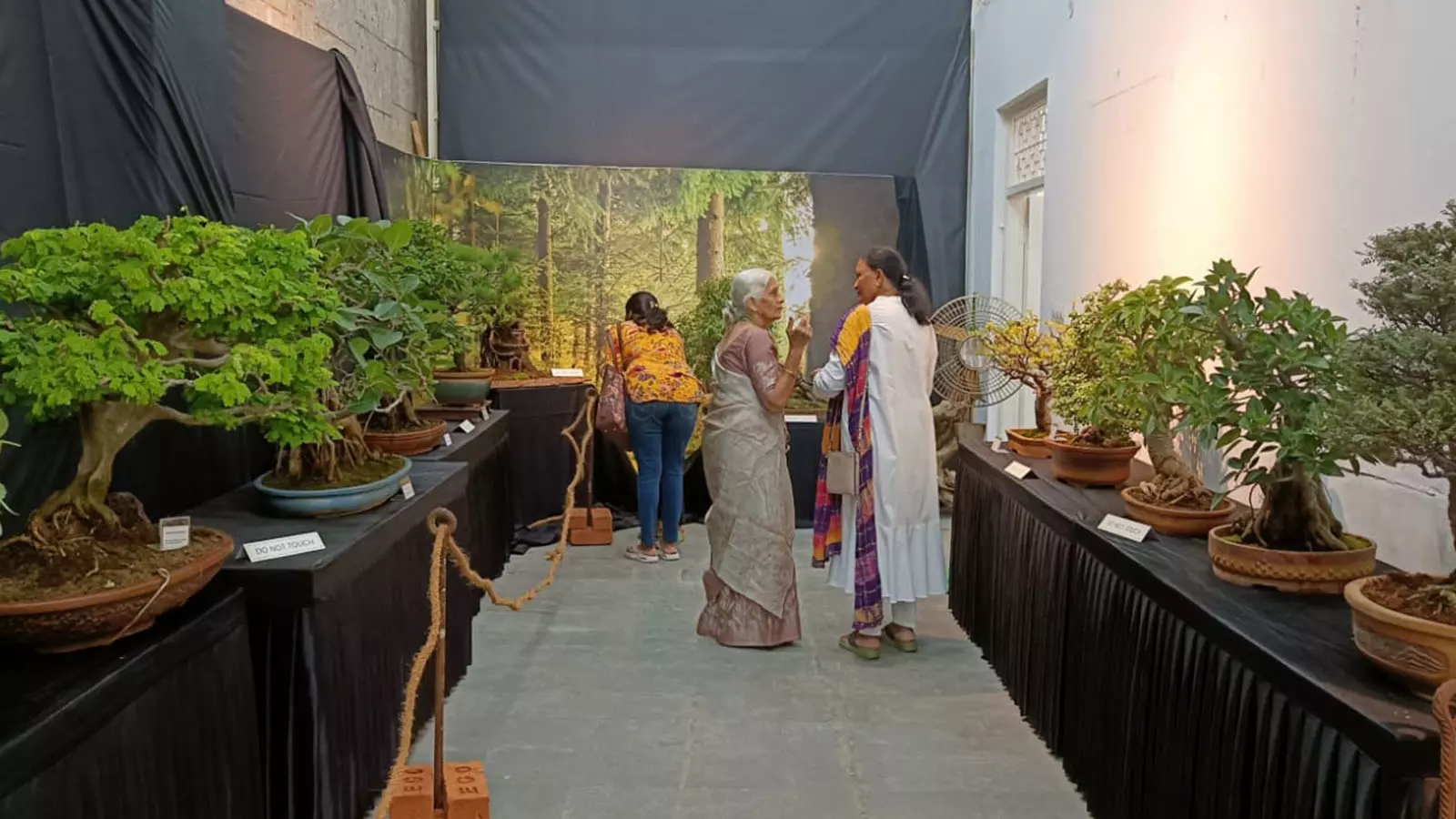
Visitors admiring bonsais displayed at the Bengaluru exhibition.
Kabra's 40-year-old "love story with bonsais" started when she saw her aunt Mandappa growing exquisitely beautiful but small trees in pots in Coorg. "I was initiated into bonsai because of my aunt. Then I attended several workshops and training classes to grow bonsais. The learning never stops," she adds.
Talking about her bougainvillea plant, Kabra says it flowers throughout the year. "Generally, for others, their bougainvilleas (bonsais) have flowers once a year. Mine is always laden with flowers. To ensure that, I give it the right water and nutrients. It is all about understanding what a plant/tree needs. Every one of them is unique and has its specific psychology. If we know all the requirements of a tree and tend it accordingly, it flourishes," she adds.
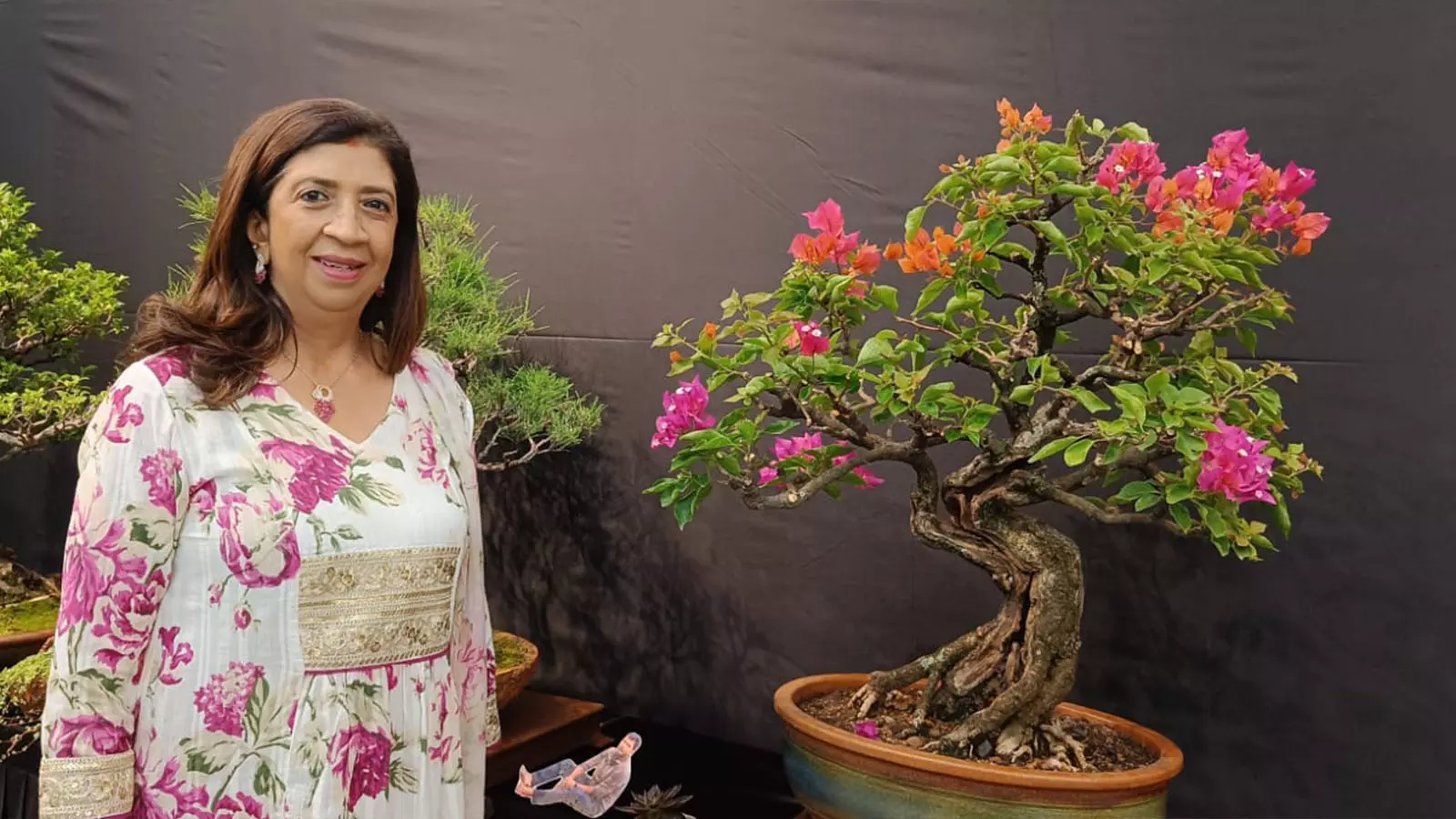
Champa Kabra poses with her 60-year-old bougainvillea plant inherited from her aunt.
Bonsai involves careful selection of plants, pruning, trimming, training and growing trees in pots. Bonsai is a Japanese art that originated in China. Bonsai growers say it's a perfect combination of science and art of growing miniature trees resembling their natural condition.
The art originated around 1,000 years ago in China. However, in Japan, the connoisseurs pursued bonsai and developed it into a highly evolved method of growing miniature trees in earthen vessels. The first Japanese record of miniature potted trees is stated to be in the Kasuga-gongen-genki (1309). Bonsais have great longevity. They can survive for a century or more and can be inherited from one generation to another.
There is a school of thought that bonsai is “unnatural” as it stunts the growth of a tree. However, bonsai practitioners disagree and emphasise that the direct inspiration for bonsai is in nature only. “We can see bonsais growing naturally in rocky crevices of high mountains or overhang cliffs as they remain diminutive and gnarled throughout their existence. Bonsai is artistic design and one of the best horticulture practices,” says Kabra.
Bonsais are best suited for an urban milieu as they require less water and space. At a time when environmental degradation and climate change have become the buzzwords, bonsais help to add aesthetic greenery into concrete urban settings and generate awareness about environmental conservation, especially trees.
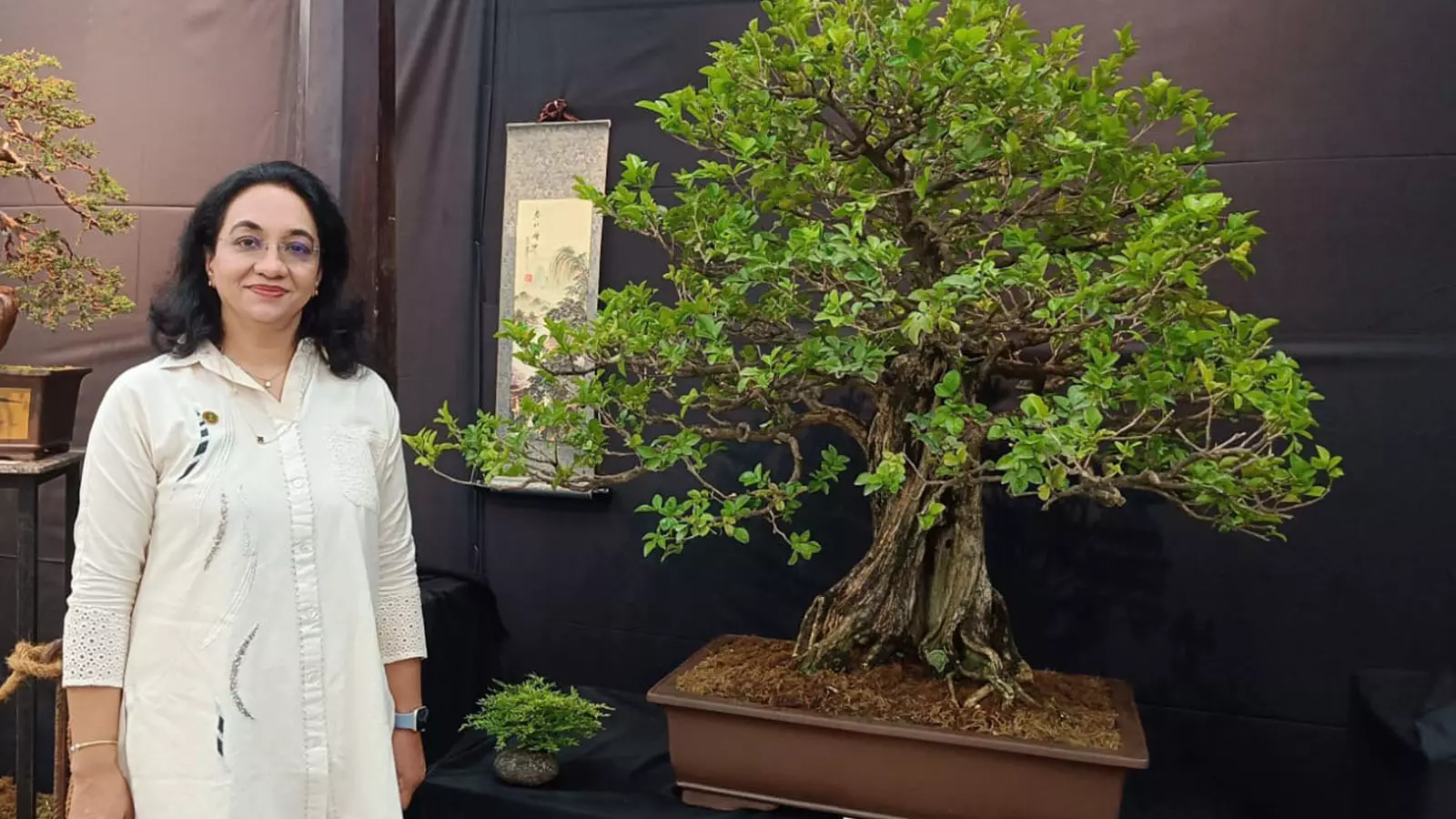
Anupama Vedachala, botanist and bonsai artist, has trained hundreds of bonsai enthusiasts to grow trees in pots.
Trees with small leaves are perfect for bonsais. "The tree has to be compact. Bonsais are outdoor plants/trees. They need regular sunlight. If one needs them indoors for display/decoration, it is advisable to keep them for a short duration," informs Kabra.
But Vedachala says that a bonsai is not a species of tree. “Many species of trees can be turned into bonsai through various techniques. A bonsai specimen can be any tree or shrub. The tree/shrub can be scaled down by pruning roots and branches and training branches by tying with wire.”
“We use our artistic skills to grow a tree into a bonsai. At the same time, we use our gardening skills to keep a tree healthy and strong,” adds Vedachala.
Speaking about the meticulous preparation behind hosting the exhibition, Uma Pandian, president of Vriksha-Bonsai Circle, says, “It is a team effort. We have been working for almost a year to host the event. The last three months have been hectic. From selecting bonsais for display to finding the right place to host hundreds of them together, it takes time, planning and brainstorming. We have got tremendous response from visitors. They appreciated the high quality of the display.”
A retired Defence Research and Development Organisation (DRDO) scientist, 75-year-old Pandian, adds that she took up bonsai as a stress buster almost 30 years ago. “I was in a high-pressure job as a scientist. I wanted an outlet to help me keep calm. Thus bonsai became my friend, philosopher and guide.”
Her colleague from Vriksha —Bonsai Circle, Amith Kumar, 47, took up the art as a 16-year-old teenager. Kumar, the treasurer of Vriksha —Bonsai Circle, says he and others took great care to decide on themes and design for the exhibition. “The exhibition created awareness about gardening and helped visitors understand a genuine bonsai from a fake one,” adds Kumar, an interior designer.
Like in Bengaluru, many cities in India—Delhi, Mumbai, Lucknow, Chennai and Coimbatore, among others—have groups dedicated to bonsais. Growers say bonsais demand time, resources and a lot of learning.
"It's worth every effort. Nature is always the best teacher. Growing bonsais has kept my stress at bay. It takes care of my mental health. My concentration power has increased because of tending to the miniature trees for almost three decades," says Vedachala, who travels 30 weeks a year around the world to conduct classes for bonsai enthusiasts.
Her next workshop is in Chennai in October. Vedachala is one of the youngest bonsai artists in India.
Sabitha Reddy, 73, has been growing bonsais for 24 years now. "I have travelled to various parts of the world including Japan and Indonesia to learn the art from masters. After I started growing bonsais, my life changed for the better. Every day, I wake up and look forward to attending to my bonsais. I love being close to nature," says Reddy, who has 150 bonsais in her house.
"Vriksha consists of members of varied professions. They share great interest and passion for bonsais. Vriksha holds workshops, critiques and classes on bonsai to help enthusiasts increase their creativity. We invite Indian and international bonsai masters for tutorials. Vriksha members also participate in India and international bonsai conventions," adds Reddy, who is also a member of Vriksha.
Brinda Pal, 32, came to the exhibition because her son Abhik, 5, loved trees. "My son is very young but he is a tree enthusiast. He always insists on going to jungle safaris. His favourite television channel is National Geographic. So I decided to bring him to the bonsai exhibition. He is thrilled to see so many potted trees. It is like a mini forest with mini trees," says Pal. Abhik adds that the forest, however, has no animals. After hearing her son, Pal laughed out loud.
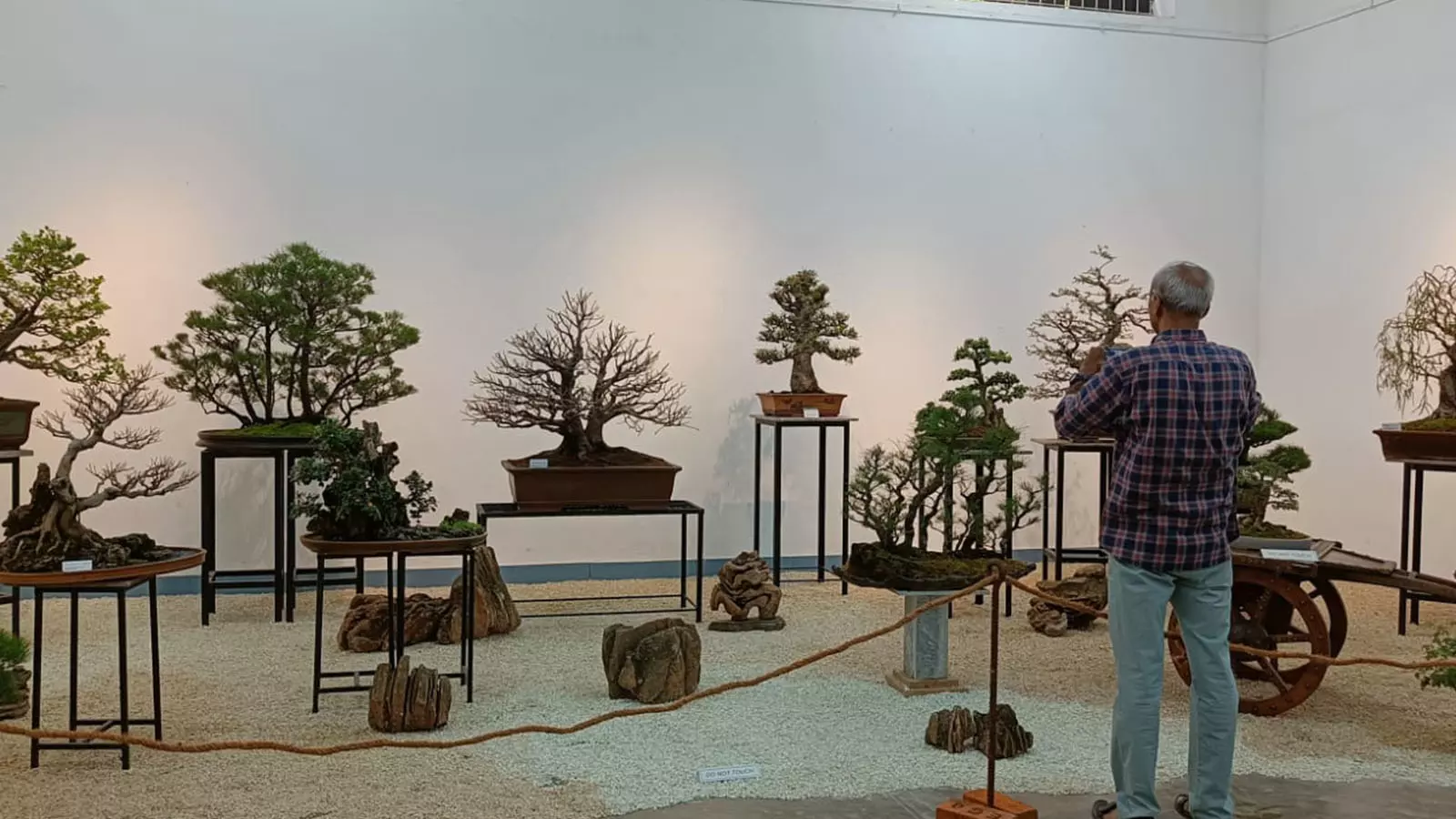
A photographer's delight: A visitor clicks pictures of trees on his mobile phone.
At the exhibition, a sizeable number of bonsais were for sale. Latha Rao, co-founder of Vriksha-Bonsai Circle and a bonsai artist, has a collection of 400 bonsais. As she wanted to downsize her collection she brought her 40-year-old ficus plant and bougainvillaea, among others, for sale.
Experts advise that bonsais should be bought from reputed sellers only. A new bonsai owner must know the tree's name and how to take care of it before buying it. "Because sudden changes can affect the plant's growth," says Kabra.
